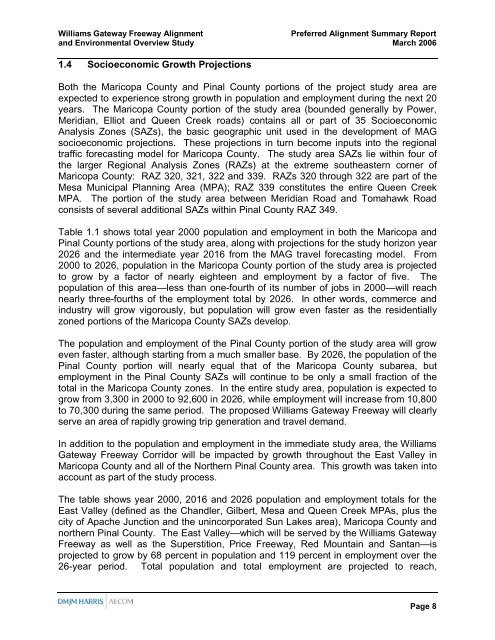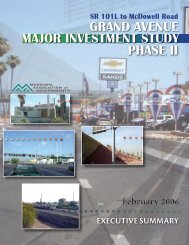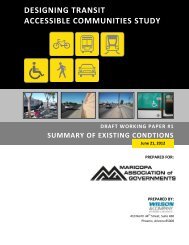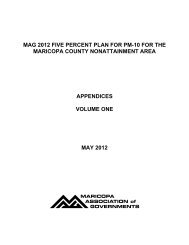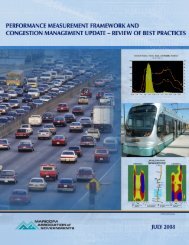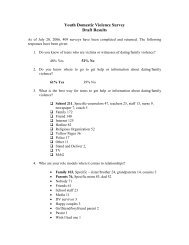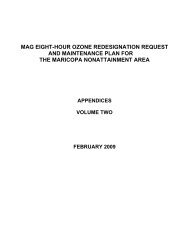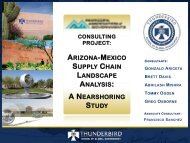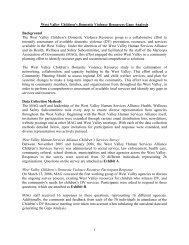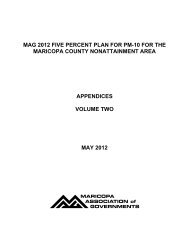Williams Gateway Freeway Preferred Alignment Report Final
Williams Gateway Freeway Preferred Alignment Report Final
Williams Gateway Freeway Preferred Alignment Report Final
Create successful ePaper yourself
Turn your PDF publications into a flip-book with our unique Google optimized e-Paper software.
<strong>Williams</strong> <strong>Gateway</strong> <strong>Freeway</strong> <strong>Alignment</strong><br />
<strong>Preferred</strong> <strong>Alignment</strong> Summary <strong>Report</strong><br />
and Environmental Overview Study March 2006<br />
1.4 Socioeconomic Growth Projections<br />
Both the Maricopa County and Pinal County portions of the project study area are<br />
expected to experience strong growth in population and employment during the next 20<br />
years. The Maricopa County portion of the study area (bounded generally by Power,<br />
Meridian, Elliot and Queen Creek roads) contains all or part of 35 Socioeconomic<br />
Analysis Zones (SAZs), the basic geographic unit used in the development of MAG<br />
socioeconomic projections. These projections in turn become inputs into the regional<br />
traffic forecasting model for Maricopa County. The study area SAZs lie within four of<br />
the larger Regional Analysis Zones (RAZs) at the extreme southeastern corner of<br />
Maricopa County: RAZ 320, 321, 322 and 339. RAZs 320 through 322 are part of the<br />
Mesa Municipal Planning Area (MPA); RAZ 339 constitutes the entire Queen Creek<br />
MPA. The portion of the study area between Meridian Road and Tomahawk Road<br />
consists of several additional SAZs within Pinal County RAZ 349.<br />
Table 1.1 shows total year 2000 population and employment in both the Maricopa and<br />
Pinal County portions of the study area, along with projections for the study horizon year<br />
2026 and the intermediate year 2016 from the MAG travel forecasting model. From<br />
2000 to 2026, population in the Maricopa County portion of the study area is projected<br />
to grow by a factor of nearly eighteen and employment by a factor of five. The<br />
population of this area—less than one-fourth of its number of jobs in 2000—will reach<br />
nearly three-fourths of the employment total by 2026. In other words, commerce and<br />
industry will grow vigorously, but population will grow even faster as the residentially<br />
zoned portions of the Maricopa County SAZs develop.<br />
The population and employment of the Pinal County portion of the study area will grow<br />
even faster, although starting from a much smaller base. By 2026, the population of the<br />
Pinal County portion will nearly equal that of the Maricopa County subarea, but<br />
employment in the Pinal County SAZs will continue to be only a small fraction of the<br />
total in the Maricopa County zones. In the entire study area, population is expected to<br />
grow from 3,300 in 2000 to 92,600 in 2026, while employment will increase from 10,800<br />
to 70,300 during the same period. The proposed <strong>Williams</strong> <strong>Gateway</strong> <strong>Freeway</strong> will clearly<br />
serve an area of rapidly growing trip generation and travel demand.<br />
In addition to the population and employment in the immediate study area, the <strong>Williams</strong><br />
<strong>Gateway</strong> <strong>Freeway</strong> Corridor will be impacted by growth throughout the East Valley in<br />
Maricopa County and all of the Northern Pinal County area. This growth was taken into<br />
account as part of the study process.<br />
The table shows year 2000, 2016 and 2026 population and employment totals for the<br />
East Valley (defined as the Chandler, Gilbert, Mesa and Queen Creek MPAs, plus the<br />
city of Apache Junction and the unincorporated Sun Lakes area), Maricopa County and<br />
northern Pinal County. The East Valley—which will be served by the <strong>Williams</strong> <strong>Gateway</strong><br />
<strong>Freeway</strong> as well as the Superstition, Price <strong>Freeway</strong>, Red Mountain and Santan—is<br />
projected to grow by 68 percent in population and 119 percent in employment over the<br />
26-year period. Total population and total employment are projected to reach,<br />
Page 8


